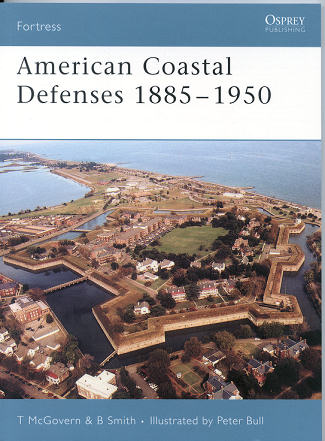 Fortress #44
concentrates on American coastal defenses in what is often called the Modern
Era. This is the time when muzzle-loading cannon were replaced by breech-loading
ones. Coastal defenses were more than just guns; it included the infrastructure
to support them and also included mines and searchlights. After all, the purpose
of these defensive systems was to allow free passage in and out of US harbors,
while keeping the bad guys at bay.
Fortress #44
concentrates on American coastal defenses in what is often called the Modern
Era. This is the time when muzzle-loading cannon were replaced by breech-loading
ones. Coastal defenses were more than just guns; it included the infrastructure
to support them and also included mines and searchlights. After all, the purpose
of these defensive systems was to allow free passage in and out of US harbors,
while keeping the bad guys at bay.
The authors start with an introduction to how it was up
until 1885; generally a rather poorly organized section of the army that was
only called upon when war broke out. Then, as often happens, things lapsed into
non-use and often decay.
The Endicott Board was convened in 1885 to take a good look
at what was needed to defend America's ports and harbors. Plans were drawn up
and work was started, albeit rather laxly. No war, no need to get things done in
a hurry. The Spanish American War sped things up as did WWI and WWII, though by
the time of the end of WWII, it was becoming obvious that the US wasn't really
in any danger of surface attack and by 1950, most defensive positions were
closed and their guns cut up as scrap.
The book includes what it was like to man these positions,
where the forts were built and how they were designed, the guns that were used,
and the types of ammunition fired by these guns. There is a section on
Army controlled submarine (as in underwater) mines and the operation of these
defenses. Fire control (or lack of it) and the development of practical systems
in an age before radar and digital computers is also covered along with the
operation and deployment of searchlights.
Finally a section on where one can go to visit many of these
sites, now run as state parks or by the National Park Service.
Overall, a most interesting look into a system that was never
used in action against enemy ships (except for those overseas) but offered a
deterrent and piece of mind to the civilian population. A book that I can easily
recommend to you.
July 2006
For more on the complete line of Osprey books,
visit www.ospreypublishing.com
or contact them at Osprey Direct, PO Box 140, Wellingborough, Northants,
NN8 2FA, UK. In the US, it is
Osprey Direct at 44-02 23rd St, Suite 219, Long Island City, NY 11101., where you can
get a catalogue of available books.
If you would like your product reviewed fairly and quickly by a
site that has over 300,000 visitors a month, please contact
me or see other details in the Note to
Contributors.
 Fortress #44
concentrates on American coastal defenses in what is often called the Modern
Era. This is the time when muzzle-loading cannon were replaced by breech-loading
ones. Coastal defenses were more than just guns; it included the infrastructure
to support them and also included mines and searchlights. After all, the purpose
of these defensive systems was to allow free passage in and out of US harbors,
while keeping the bad guys at bay.
Fortress #44
concentrates on American coastal defenses in what is often called the Modern
Era. This is the time when muzzle-loading cannon were replaced by breech-loading
ones. Coastal defenses were more than just guns; it included the infrastructure
to support them and also included mines and searchlights. After all, the purpose
of these defensive systems was to allow free passage in and out of US harbors,
while keeping the bad guys at bay.